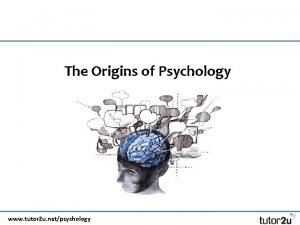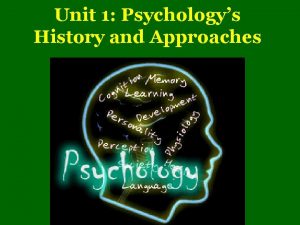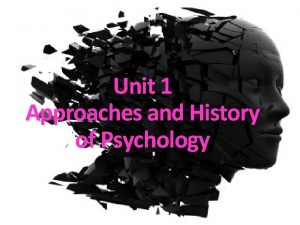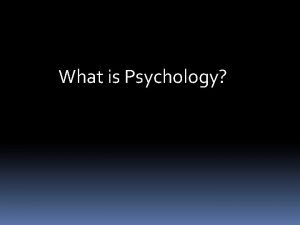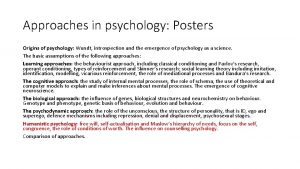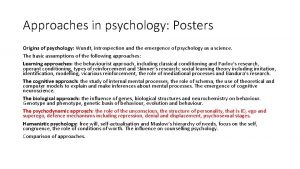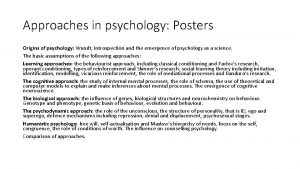Approaches in Psychology 1 Origins in Psychology Outline

![[1] Origins in Psychology Outline: Wundt and Introspection – in 1879 Germany, Wilhelm Wundt [1] Origins in Psychology Outline: Wundt and Introspection – in 1879 Germany, Wilhelm Wundt](https://slidetodoc.com/presentation_image_h2/337e0e53ed890cd6ddc1c7093f6132eb/image-2.jpg)
![[2] Learning Approach: Behaviourism Outline: Concerned only with behaviour that can Outline: Operant Conditioning [2] Learning Approach: Behaviourism Outline: Concerned only with behaviour that can Outline: Operant Conditioning](https://slidetodoc.com/presentation_image_h2/337e0e53ed890cd6ddc1c7093f6132eb/image-3.jpg)
![[3] The Learning Approach: Social Learning Theory Outline: Behaviour occurs through experience in a [3] The Learning Approach: Social Learning Theory Outline: Behaviour occurs through experience in a](https://slidetodoc.com/presentation_image_h2/337e0e53ed890cd6ddc1c7093f6132eb/image-4.jpg)
![[4] The Cognitive Approach Outline: Suggests that mental processes should be Outline: Schema are [4] The Cognitive Approach Outline: Suggests that mental processes should be Outline: Schema are](https://slidetodoc.com/presentation_image_h2/337e0e53ed890cd6ddc1c7093f6132eb/image-5.jpg)
![[5] The Biological Approach Outline: Assumes that we must look into biological structures and [5] The Biological Approach Outline: Assumes that we must look into biological structures and](https://slidetodoc.com/presentation_image_h2/337e0e53ed890cd6ddc1c7093f6132eb/image-6.jpg)
![[6] The Psychodynamic Approach Outline: Assumes that the unconscious influences behaviour. Freud suggested that [6] The Psychodynamic Approach Outline: Assumes that the unconscious influences behaviour. Freud suggested that](https://slidetodoc.com/presentation_image_h2/337e0e53ed890cd6ddc1c7093f6132eb/image-7.jpg)
![[7] The Humanistic Approach Outline: Rejects attempts to establish scientific principles of behaviour. People [7] The Humanistic Approach Outline: Rejects attempts to establish scientific principles of behaviour. People](https://slidetodoc.com/presentation_image_h2/337e0e53ed890cd6ddc1c7093f6132eb/image-8.jpg)
![[8] Comparisons of Approaches Approach Behaviourist Social Learning Cognitive Biological Psychodynamic Humanistic Views on [8] Comparisons of Approaches Approach Behaviourist Social Learning Cognitive Biological Psychodynamic Humanistic Views on](https://slidetodoc.com/presentation_image_h2/337e0e53ed890cd6ddc1c7093f6132eb/image-9.jpg)
- Slides: 9

Approaches in Psychology
![1 Origins in Psychology Outline Wundt and Introspection in 1879 Germany Wilhelm Wundt [1] Origins in Psychology Outline: Wundt and Introspection – in 1879 Germany, Wilhelm Wundt](https://slidetodoc.com/presentation_image_h2/337e0e53ed890cd6ddc1c7093f6132eb/image-2.jpg)
[1] Origins in Psychology Outline: Wundt and Introspection – in 1879 Germany, Wilhelm Wundt wanted to describe the nature of human consciousness and established the first psychological lab. He pioneered the first method of introspection (the first systematic experimental attempt to study the mind by breaking it up into basic structures of: thoughts, images and sensations). Standardised instructions were given and procedures could be repeated (e. g. metronome). Wundt’s work seemed naïve although it helped psychology become more scientific. Eval 2: Some aspects of the research aren’t scientific – Wundt relied on participants self reporting their private mental processes which is subjective and some may not want to reveal some thoughts. Thoughts would not have been the same every time, so generic principles couldn’t have been made. Therefore, Wundt’s methods were naïve and didn’t meet scientific criteria. Outline: Emergence of Psychology as a science – 1900 s early behaviourists rejected Eval 1: Wundt’s Methods are scientific – He recorded introspections within a controlled lab environment. He used standardized procedures, so that all participants received instructions and were tested in the same way. Therefore, Wundt’s research can be described as the foundation of scientific approaches in psychology that were to come. Eval 3: Research in modern psychology can claim to be scientific – Psychology has same aims as natural science (to understand, describe, predict and control world). The learning, biological and biological approach all use scientific methods (lab studies) to investigate theories (controlled). Therefore, psychology has established itself as a scientific discipline. Eval 4: Not all approaches use objective methods – the humanistic approach is antiscientific as it doesn’t formulate general laws bout behaviour. It only concerns subjective experience. The psychodynamic approach uses case studies which are open to subjective bias. Therefore, many believe that scientific approach to studying the min isn’t possible as there important differences in what's being studied in psychology and natural sciences. introspection as it was subjective – science only studies measurable. 1930 behaviourist scientific approach dominated psychology as Skinner brought scientific language and rigour into it (focused on learning through lab studies). 1950 s cognitive approach used scientific procedures to study mental processes and make inferences about how they work through lab experiments. 1990 s biological approach introduced technological advances including recording brain activity, using scanning techniques (e. g. f. MRI or EEG) and advanced genetic research.
![2 Learning Approach Behaviourism Outline Concerned only with behaviour that can Outline Operant Conditioning [2] Learning Approach: Behaviourism Outline: Concerned only with behaviour that can Outline: Operant Conditioning](https://slidetodoc.com/presentation_image_h2/337e0e53ed890cd6ddc1c7093f6132eb/image-3.jpg)
[2] Learning Approach: Behaviourism Outline: Concerned only with behaviour that can Outline: Operant Conditioning (Skinner) – Eval 1: Behaviourism gave psychology be observed and measured. Isn't concerned with Learning through operating in environment, scientific credibility – this approach focused mental processes as they are hard to measure. behaviour is shaped and maintained through on careful measurement and observable Uses lab studies and uses non-human animals as consequences. Skinner – rats were put in a box behaviour in a lab setting. It emphasised the learning is governed the same way in them as they where activating a lever dispensed food, which was role of scientific approaches such as are in humans. desirable so the behaviour repeated. If activating replication and objectivity, bringing Classical Conditioning (Pavlov): Conditioned dogs to the lever meant avoiding an electric shock, the languages of natural sciences into salivate to sound of bell. UCS = food, UCR = behaviour would also be repeated. • Positive Reinforcement: when a behaviour is rewarded psychology giving it greater credibility and salivation and NS = bell sound. Bell sound became • Negative Reinforcement: when a behaviour is associated with food after being paired several status. times. Bell became CS producing salivation (now CR). • Eval 2: Laws developed by behaviourists have real-life application – principles of conditioning have been applied to a broad range of real-world behaviours. For example, token economy systems reward desirable behaviour with token that grant privileges. These are successful in prisons and psychiatric wards. These applications are good for people that are not capable of talking about their problems. performed to avoid something unpleasant Punishment: an unpleasant consequence of behaviour. Eval 3: Behaviourism portrays mechanistic view – Animals and humans are seen like passive, machine-like responders to environment and have no insight into this. Social learning theory and cognitive approach consider mental processes. Processes suggests that humans are more involved in learning than behaviourism suggests. Eval 4: Behaviourism is another form of environmental determinism – Behaviourism sees behaviour as determined by past experiences and ignores free will. Skinner suggested that free will was an illusion as past experiences always determine our behaviour. This ignores any conscious influence on decision making on behaviour as the cognitive approach suggests exists. Extra Evaluation Point: Animal research has ethical and practical issues – although experimental conditions allowed good control, ethical issues were also involved in Skinner’s study. Animals were exposed to stressful conditions (shock) which may have affected their reaction to the experimental situation. Therefore validity of Skinner’s findings can be questioned.
![3 The Learning Approach Social Learning Theory Outline Behaviour occurs through experience in a [3] The Learning Approach: Social Learning Theory Outline: Behaviour occurs through experience in a](https://slidetodoc.com/presentation_image_h2/337e0e53ed890cd6ddc1c7093f6132eb/image-4.jpg)
[3] The Learning Approach: Social Learning Theory Outline: Behaviour occurs through experience in a Outline: Bandura’s research 1 – watched an adult social context through observation and imitation. Children observe other people’s behaviour and note its consequences. Behaviour that is rewarded is imitated more than behaviour that is punished. This is called vicarious reinforcement. Mediational (cognitive) processes play a role in learning: 1. 2. 3. 4. Attention: noticing behaviour Retention: remembering behaviour Motor reproduction: being able to imitate behaviour Motivation: the will to perform behaviour Children are more likely to imitate people that people they identify with (e. g. attractive, high status). Eval 2: SLT relies heavily on evidence from lab studies – Bandura used controlled observations to develop his ideas. This may have resulted in demand characteristics. The main purpose of a bobo doll is to hit it, so children knowing they were being studied may have hit it because they thought they had to. This means Bandura’s study may not tell us anything about learning. Eval 1: Emphasises importance of cognitive either behave aggressively or non aggressively factors in learning – Classical conditioning towards bobo doll. When given their own bobo and operant conditioning are limited doll, those who observed aggressive behaviour was explanations of learning as they ignore more aggressive towards doll. Bandura research 2 – cognitive factors. Humans and animals store Children saw adult that was either punished, data about the behaviour of others which rewarded or neither. When given bobo doll, influences their own. SLT therefore provides children that saw aggression rewarded, imitated a complete explanation of human learning as aggression themselves. Aggressive behaviour is more likely to be repeated it recognises the role of mediation processes. if it is modelled by an adult role model and the behaviour is rewarded. Eval 3: SLT underestimates the influence of biological factors – Result from Bandura’s experiments showed that boys were more aggressive than girls regardless of the conditions. This is due to higher testosterone levels in boys which is linked to aggression. Therefore, Bandura’s study may show biological factors in aggression and not learning behaviour. Eval 4: SLT can account for cultural differences in behaviour – SLT principles explains how children learn from the people around them as well as through media which can explain how norms are transmitted. This helps understand lots of behaviours. The biological approach on the other hand can only explain behaviour through biological processes that aren’t culturally relative. Extra Evaluation Point: SLT is less deterministic than the behaviourist approach – Bandura emphasised reciprocal determinism, where we are influenced by our environment but also exert influence on it through our behaviour we choose to perform. Therefore, SLT recognises that we have free will which makes it a more flexible approach compared to the behaviourist approach.
![4 The Cognitive Approach Outline Suggests that mental processes should be Outline Schema are [4] The Cognitive Approach Outline: Suggests that mental processes should be Outline: Schema are](https://slidetodoc.com/presentation_image_h2/337e0e53ed890cd6ddc1c7093f6132eb/image-5.jpg)
[4] The Cognitive Approach Outline: Suggests that mental processes should be Outline: Schema are packages of info developed studied scientifically. Mental processes are private, so should be studied indirectly by making inferences based on observed behaviour. Theoretical models are used to describe and explain mental processes (info slows through a sequence of stages e. g. input, storage and retrieval). Computer models are also used to describe mental processes (programmes are run on a computer to imitate human mind, to identify whether ideas about mental processing is correct). through experience which act a mental framework for the interpretation of incoming info. Babies are born with innate simple motor schema for behaviours such as sucking. When we get older our schema becomes more detailed. Cognitive neuroscience has emerged which studies the influence of brain structures on mental processes through advanced scanning techniques and are able to describe the neurological basis of it. E. g. studies on different types of LTM, prefrontal cortex and even disorders. Eval 1: Approach uses scientific and objective methods – Cognitive psychologists use controlled methods of study such as lab studies, which has enabled biology and cognitive psychology come together (cognitive neuroscience). therefore, the study of the mind has become more credible as a scientific basis. Eval 2: Approach based on machine reductionism – the analogy of computers as the human mind has been criticised despite similarities between them. e. g. emotion and motivation influences EWT which isn’t considered with the information-processing model. This shows that cognitive approach is oversimplified and ignores human factors that can influence behaviour. Eval 3: Research support lacks external validity – cognitive psychologists can only infer behaviour that they can observe so approaches can be too abstract and theoretical. Research is also often carried out using artificial stimuli which doesn’t represent everyday experience. Therefore research on cognitive processes lacks external validity. Eval 4: Application to everyday life – The cognitive approach is dominant today and can be applied to a lot of practical and theoretical approaches. E. g. the cognitive approach has had an important contribution to artificial intelligence. These advancements may revolutionise the future we live in. Extra Evaluation Point: The approach is less deterministic than other approaches – the cognitive theory is based on soft determinism as it recognises that out cognitive system can only operate to certain limits and we are free to think before responding to a stimulus. Behaviourism on the other hand believes that our behaviour is determined by our environment. This makes the cognitive approach a flexible explanation of behaviour.
![5 The Biological Approach Outline Assumes that we must look into biological structures and [5] The Biological Approach Outline: Assumes that we must look into biological structures and](https://slidetodoc.com/presentation_image_h2/337e0e53ed890cd6ddc1c7093f6132eb/image-6.jpg)
[5] The Biological Approach Outline: Assumes that we must look into biological structures and processes within the human body to fully understand human behaviour. Behaviours have a genetic and neurochemical base so behaviours are inherited. The mind and the body are the same so thoughts, feeling and behaviour has a physical basis. Twin studies support this theory – concordance rates (extent of similarity) between twins are calculated. Higher concordance rate among identical twins (MZ) than non-identical twins (DZ). Outline: Genotypes people’s genetic makeup and phenotypes are the way that genes are expressed e. g. through appearance. Phenotypes are influenced by environment which means that human behaviour depends on the interaction between nature and nurture. The theory of evolution is used to explain aspects of behaviour. Darwin – natural selection: genetically determined behaviour enhances survival and passed on to future generation. These are adaptive genes. Eval 1: Approach uses scientific methods – The biological approach uses precise and highly scientific approaches to investigate the genetic basis of behaviour. These include drug trials and scanning techniques (e. g. f. MRIs). Therefore they can be measure without bias so the biological process is based on reliable data. Eval 2: Approach has real-life applications – increased understanding of biochemical processes has led to the development of psychoactive drugs that are used to treat serious mental disorders (e. g. depression). They have revolution treatment for many patients. This is an advantage as it has led to people being able to live normal lives rather than on a hospital. Eval 3: Difficulty establishing cause and effect with neurotransmitters – the view that neurotransmitters are involved in behaviour comes from studies that show that a particular drug reduces symptoms of a disorder by changing neurotransmitter levels. The biological approach assumes that neurotransmitter levels is the cause. This is a limitation as the biological approach claim causes when there are only associations. Eval 4: Approach is based on determinist view of behaviour – It sees human behaviour as governed by internal biological causes which we have no control over. The legal system sees people as responsible for their own behaviour which led to a complicated ‘criminal gene’. Therefore, research may have negative implications for criminals, excusing their behaviour. Extra Evaluation Point: Difficulty of separating nature and nurture – identical twins share the same genetics so behave similarly, however this could be due to the same environments they live on rather than genetics. The environment acts as an important confounding variable which is a problem for the biological approach as it can be interpreted as more nature than nurture.
![6 The Psychodynamic Approach Outline Assumes that the unconscious influences behaviour Freud suggested that [6] The Psychodynamic Approach Outline: Assumes that the unconscious influences behaviour. Freud suggested that](https://slidetodoc.com/presentation_image_h2/337e0e53ed890cd6ddc1c7093f6132eb/image-7.jpg)
[6] The Psychodynamic Approach Outline: Assumes that the unconscious influences behaviour. Freud suggested that the mind is made up of conscious (what we are aware of), preconscious (memories we aren’t currently aware of but can be accessed) and unconscious (what we are unaware of – instincts). Freud also suggested that personality has a tripartite structure: Id (Pleasure principle, immediate gratification), Ego (reality principle, mediator between id and superego) and Superego (morality principle punishes ego through guilt – right/wrong). Eval 2: Case study used by Freud is criticised – Freud developed his ideas through case studies which critics have suggested can’t be the basis of a universal claim about human nature as the sample is limited. Freud's observations were open to bias and were subjective, so others wouldn't have drawn the same conclusions. Therefore it lacks scientific rigour. Outline: There are 5 psychosexual stages that determine adult personality. Each stage has a conflict that must be overcome to move on: 1. 2. 3. 4. 5. Oral (0 -1 years): pleasure focus = mouth (breastfeeding) Anal (1 -3 years): pleasure focus = anus (releasing feces) Phallic (3 -5 years): pleasure focus = genital area Latency – earlier conflicts are repressed Genital (Puberty) – sexual desires become conscious. Oedipus complex occurs at phallic stage where little boys develop incestuous feeling towards mother and hatred towards father which are later repressed. Defence mechanisms are used by the ego to keep id in check and reduce anxiety: Repression (forcing distressing memory out), Denial (refusing to acknowledge reality) and Displacement (transferring feelings elsewhere). Eval 3: Approach includes lots of untestable concepts – Popper suggested that Freud’s theory is not scientific as it is not falsifiable. Concepts such as Oedipus complex occur at the unconscious level, so are impossible to measure. Therefore, the psychodynamic approach is a pseudoscience rather than a real science. Eval 1: Approach has good explanatory power – Freud’s theory has a huge influence on Western thought. It has been used to explain a wide range of behaviours such as moral or mental disorders. It also draws the attention to childhood on adult personality. It dominated alongside behaviourism in the first half of the twentieth century. Eval 4: Approach has practical application in real world – Freud introduced psychoanalysis which is a therapy used access the unconscious using techniques such as dream analysis. This is suitable for mild neuroses. Psychoanalysis is the forerunner of many psychotherapies that have been established. Extra Evaluation Point: Approach based on psychic determinism – The psychodynamic approach explains all behaviour as determined by unconscious conflicts that are rooted in childhood. Even something as random as a ‘slip of the tongue’ is driven by unconscious forces. Therefore, the psychodynamic approach is not a flexible explanation as it ignores free will.
![7 The Humanistic Approach Outline Rejects attempts to establish scientific principles of behaviour People [7] The Humanistic Approach Outline: Rejects attempts to establish scientific principles of behaviour. People](https://slidetodoc.com/presentation_image_h2/337e0e53ed890cd6ddc1c7093f6132eb/image-8.jpg)
[7] The Humanistic Approach Outline: Rejects attempts to establish scientific principles of behaviour. People have free will, so psychology should concern itself with the study of subjective experience. Maslow’s hierarchy of needs has 5 needs that need to be met in order to proceed to the next stage. At the top is self-actualisation which is the desire for self-fulfilment. All previous needs must be met to be able to achieve selfactualisation. This approach focuses on the self (ideas and values that characterise ones perception of themselves). Eval 2: Approach has limited application to the real world – Roger’s therapy revolutionized counselling techniques and Maslow's hierarchy of needs helped improve work conditions, but the humanistic approach has had limited impact within psychology as a whole compared to other approaches due to lack of evidence. Therefore, it I seen as a loose set of concepts rather than a comprehensive system. Outline: Rogers argues that one’s concept of self Eval 1: Approach is anti-reductionist – The must be congruent with their ideal self (what they humanistic approach rejects attempts to want to be) in order to achieve self-actualisation – break down behaviour into smaller impossible if gap is too big. Issues such as components taking a holistic approach – worthlessness and low self-esteem may prevent self subjective experience can only be understood -actualisation. These issues have roots in childhood – parents who set boundaries on love for their child by considering the whole person (e. g. their relationships). This gives theory more (conditions of worth) may cause their child to have future psychological issues. Rogers proposed a client validity as it considers meaningful human -centred therapy to improve self-esteem where behaviour within its natural context. therapists provide patient with genuineness, empathy and unconditional positive regard. This transformed psychotherapy. Eval 3: Approach is a positive one – Humanistic approach has been praised for promoting a positive image of human condition (people have free will). Freud suggested that humans are slaves to their past and that we exist somewhere between common unhappiness and despair. The humanistic approach provides an optimistic alternative. Eval 4: Approach includes untestable concepts – Humanistic approach includes vague ideas that are difficult to test such as self-actualization and congruence. Although Roger attempted to introduce more rigour through a q-sort (objective measure in therapy), it wasn’t enough. Therefore, compared to other approaches, the humanistic approach is non scientific and lacks empirical evidence. Extra Evaluation Point: Approach may have a Western cultural bias – Humanistic approach emphasises concepts such as freedom and personal growth which would be associated with individualist cultures (Western). Collectivist cultures (e. g. India) emphasise group needs so don’t identify with humanistic values. Therefore, the humanistic approach isn’t universal and is a product of cultural concept.
![8 Comparisons of Approaches Approach Behaviourist Social Learning Cognitive Biological Psychodynamic Humanistic Views on [8] Comparisons of Approaches Approach Behaviourist Social Learning Cognitive Biological Psychodynamic Humanistic Views on](https://slidetodoc.com/presentation_image_h2/337e0e53ed890cd6ddc1c7093f6132eb/image-9.jpg)
[8] Comparisons of Approaches Approach Behaviourist Social Learning Cognitive Biological Psychodynamic Humanistic Views on development Processes underpin learning occur at any age and are continuous Processes that underpin learning occur at any age and are continuous People develop more detailed schema as they get older Behaviour influenced by maturational changes that are genetically determined Concepts and processes are tied to certain ages (e. g. phallic). Most coherent Self-development are ongoing throughout life Nature vs Nurture Behaviour is learned through association and it is reinforced by consequences Same as behaviourism, but observation and imitation is involved Information-processing abilities are innate, but are constantly refined by experience Behaviour determined by genetics inherited from parents Behaviour driven by biological drives and instincts. Child’s relationship with parents is crucial Parents, friends and wider society has a critical impact on person’s self-concept Reductionism Reduces learning into testable stimulusresponse units Recognises how cognitive factors interact with external environment Machine reductionism: information-processing analogy, ignores human emotion Reduces behaviour to genes Reduces behaviour to influence of biological drives. Personality seen as a holistic and dynamic interaction Anti-reductionist. Holistic explanation of all aspects of individual Determinism All behaviour determined by external forces we can’t control Influenced by environment, but we exert influence upon it (reciprocal determinism) We choose our behaviour, but can only choose from what we know (soft determinism) Genetic determinism, behaviour influenced by genetics Psychic determinism, behaviour determined by unconscious forces – rationalised by conscious mind Humans have free will and determine their development Explanation and treatment of atypical behaviour Abnormality from faulty learning. Behavioural therapies to unlearn behaviour (symptombased) Modelling used to explain aggressive behaviour Led to development of CBT to treat depression by eradicating faulty thinking Psychoactive drugs regulate chemical imbalances in the brain revolutionised treatments of mental disorders Anxiety disorders arise from unconscious conflicts and overuse of defence mechanisms. Psychoanalysis aims to put people in touch with unconscious thoughts Humanistic counselling/therapy is based on reducing incongruence to stimulate personal growth
 Origins of psychology tutor2u
Origins of psychology tutor2u Outline critical approaches to interpreting text
Outline critical approaches to interpreting text Unit 1 psychology's history and approaches
Unit 1 psychology's history and approaches How did wilhelm wundt break down consciousness
How did wilhelm wundt break down consciousness The 7 approaches to psychology
The 7 approaches to psychology Structuralism vs functionalism psychology
Structuralism vs functionalism psychology Ap psychology module 2 review
Ap psychology module 2 review Graphic organizer activity 1 approaches to psychology
Graphic organizer activity 1 approaches to psychology Rogers humanistic theory
Rogers humanistic theory Seven approaches to psychology
Seven approaches to psychology
